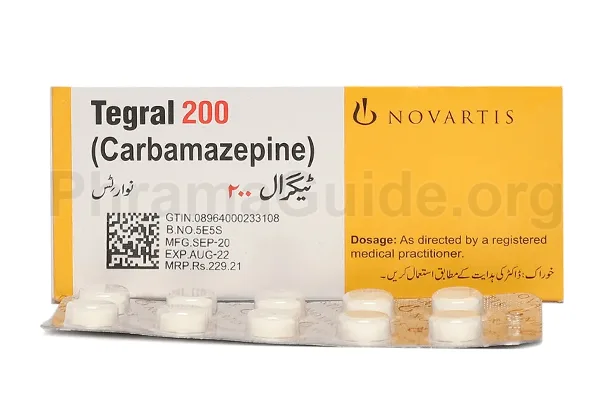Tegral tablet is primarily used for the treatment of epilepsy and certain mood disorders. It belongs to the class of drugs known as anticonvulsants or antiepileptic drugs. Following are some common uses of Tegral Tablet:
- Epilepsy: Tegral tablet is commonly used as an anticonvulsant for the treatment of various types of epilepsy, including partial seizures, generalized tonic-clonic seizures, and mixed seizure patterns.
- Trigeminal Neuralgia: Tegral tablet is highly effective in the treatment of trigeminal neuralgia, a severe facial pain condition that is characterized by sudden, intense facial pain. Tegral Table can help alleviate intense facial pain and improve the quality of life for individuals with this condition.
- Bipolar Disorder: Tegral tablet is used as a mood stabilizer in the management of bipolar disorder. It can help control mood swings and reduce the frequency and severity of manic and depressive episodes.
- Neuropathic Pain: Tegral tablets may be prescribed for the treatment of neuropathic pain, which is pain resulting from nerve damage or dysfunction. It can help alleviate pain associated with conditions such as diabetic neuropathy, postherpetic neuralgia, and trigeminal neuralgia.
Off-label Uses of Tegral Tablet
- Neuropathic Pain: Tegral tablet is sometimes used off-label for the management of various neuropathic pain conditions, including diabetic neuropathy, postherpetic neuralgia, and other types of nerve-related pain. It may help in reducing pain symptoms by modulating abnormal nerve signaling.
- Alcohol Withdrawal: Tegral tablet has been used to manage symptoms of alcohol withdrawal. It may assist in reducing the severity of withdrawal symptoms, such as tremors, anxiety, and cravings.
- Attention Deficit Hyperactivity Disorder (ADHD): In some cases, Tegral tablet has been used as an adjunct treatment for ADHD, especially when other medications have been ineffective or poorly tolerated.
- Post-Traumatic Stress Disorder (PTSD): Tegral tablet has been explored off-label as a potential treatment for certain symptoms associated with PTSD, such as hyperarousal and irritability.
- Cluster Headaches: Tegral tablets may be used as a preventive treatment for cluster headaches, a type of severe headache that occurs in clusters or cycles.
- Other Seizure Disorders: While Tegral tablet is primarily indicated for certain types of epilepsy, it may be used off-label for other seizure disorders that are not responsive to other medications.
- Phantom Limb Pain: Tegral tablets may be used to alleviate phantom limb pain, a condition where individuals experience pain or discomfort in a limb that has been amputated.

What is Tegral?
Tegral is one of the leading brands of Carbamazepine, manufactured and marketed by Novartis Pharma (Pakistan).
Tegral Alternatives : Other Similar Brands
The following are some alternative brands of Tegral and their manufacturers.
- Sezunil : Platinum Pharmaceuticals (Pvt) Ltd, Pakistan.
- Teril : Martin Dow Pharmaceuticals, Pakistan.
- Epitab : Werrick Pharmaceuticals, Pakistan.
- Epicar : Adamjee Pharmaceuticals (Pvt) Ltd, Pakistan.
- Epilepsin : Macter International (Pvt) Ltd, Pakistan.
- Carbascot : Scotmann Pharmaceuticals, Pakistan.
- Lexopine : Highnoon Laboratories Ltd, Pakistan.
- Xepil : Shaigan Pharmaceuticals (Pvt) Ltd, Pakistan.
- Carbasan : Searle (Pakistan) Pvt, Ltd.
- Convul : Siza International (Pvt) Ltd, Pakistan.
Tegral : Available Formulations and Strengths
Presently, Tegral is available in Tablet and Suspension form with the following strengths.
Tegral Tablet : 200mg strength.
Tegral Suspension : 100mg/5ml strength.
Who Should Not Use Tegral?
Tegral has several contraindications, and its use should be avoided in the following situations:
Hypersensitivity or allergy: Tegral should not be used in individuals who have a known hypersensitivity or allergy to Tegral’s components.
Bone marrow suppression: Tegral is contraindicated in individuals with a history of bone marrow suppression, which can include conditions such as aplastic anemia and agranulocytosis. It can further suppress bone marrow function and lead to serious blood disorders.
Known history of hypersensitivity to tricyclic antidepressants: Tegral should not be used in individuals with a known hypersensitivity to tricyclic antidepressants, as cross-reactivity can occur.
Concurrent use with monoamine oxidase inhibitors (MAOIs): Tegral is contraindicated in individuals who are currently taking or have recently taken (within 14 days) MAOIs, as it can increase the risk of serotonin syndrome, a potentially life-threatening condition.
History of porphyria: Tegral is contraindicated in individuals with a history of porphyria, a group of rare metabolic disorders that affect the production of heme, a component of hemoglobin.
Pregnancy and breast-feeding: Tegral is contraindicated during pregnancy, particularly in the first trimester, due to the potential risk of fetal harm. It is also contraindicated during breastfeeding, as it can be excreted in breast milk and may cause adverse effects in nursing infants.
What is the Recommended Daily Dosage of Tegral?
Tegral Dose for Epilepsy:
- Adults: One tablet of 200mg once or twice a day. The dosage may be gradually increased based on response and tolerability, up to a maximum of six tablets (1200mg) per day.
- Children: The initial daily dose is usually 10 to 20 mg per kg of body weight, divided into two or three doses. The dosage may be adjusted based on response and tolerability, up to a maximum of 35 mg per kilogram of body weight per day.
Tegral Dose for Trigeminal neuralgia:
- The initial daily dose is typically 100 to 200 mg divided into two or three doses. The dosage may be gradually increased based on response and tolerability, up to a maximum of 1,200 mg per day.
Tegral Dose for Bipolar disorder:
- One tablet of 200mg once or twice a day. The dosage may be increased based on response and tolerability, typically up to a maximum of eight tablets (1,600mg) per day.
How Tegral Works?
Tegral blocks voltage-gated sodium channels in neurons. By binding to these channels, it inhibits the influx of sodium ions, which is necessary for the generation and propagation of action potentials. This action helps stabilize the electrical activity in the brain and prevents the excessive firing of neurons, thereby reducing seizure activity.

Leave A Comment